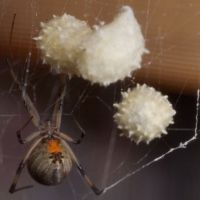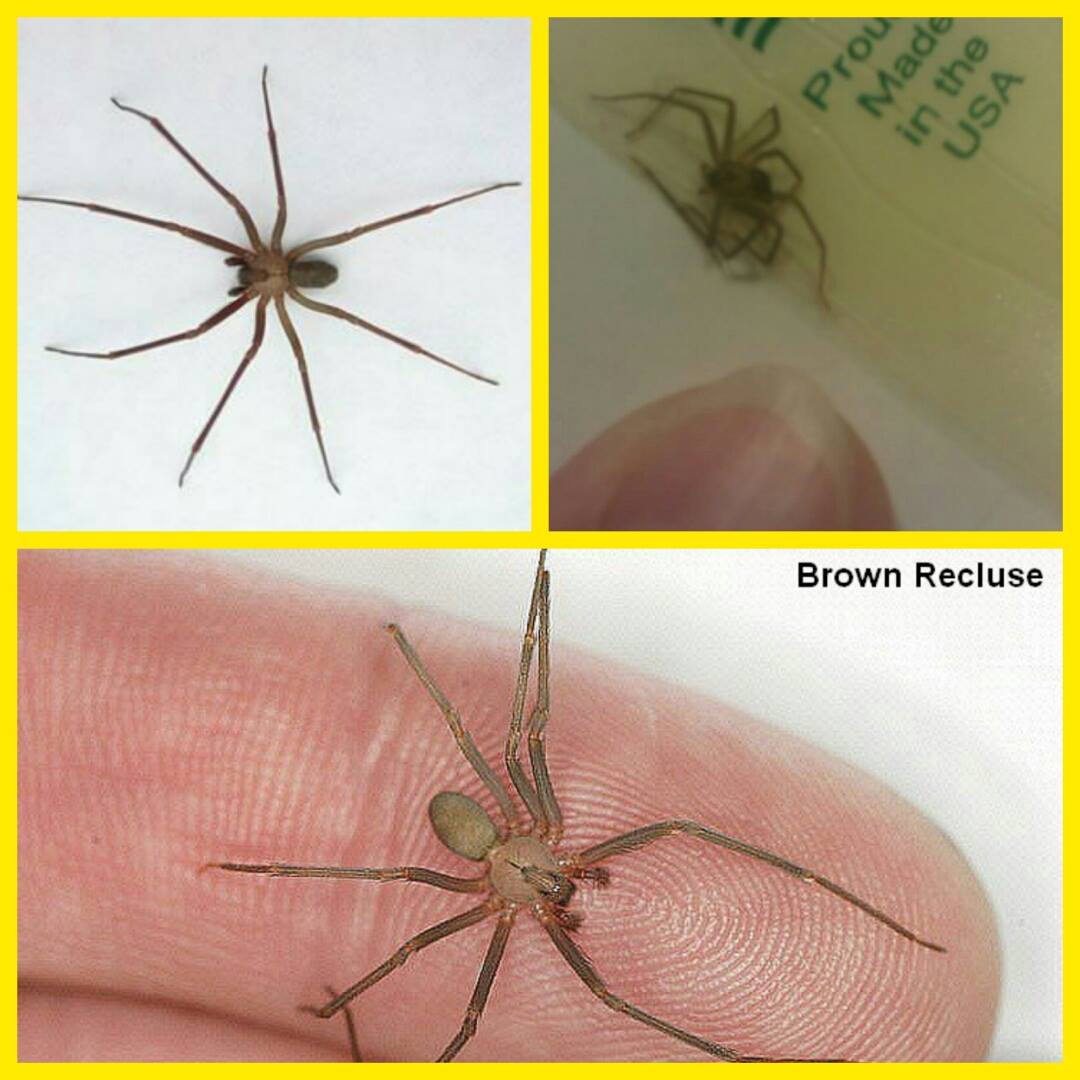Spiders
The most common spiders you may find in your home are:
- The Common House Spider
- The Black Widow Spider
- The Cellar Spider
- The Wolf Spider
- The Brown Recluse Spider
The Common House Spider
The Common House Spider is also referred to as the American House Spider. The American House Spiders build their tangled web in or near human dwellings, often in secluded areas such as between loose walls, behind open doors and attic windows. They are generally dull in appearance with patterns consisting of brown shades of coloration, often giving a vague spotted appearance that is particularly noticeable on the legs. Their average body size is a quarter of an inch long, but they can be an inch or more across with legs spread. These traits allow the spiders to blend into the background and escape notice. American House Spiders usually feed on household pests such as flies, mosquitoes, ants and wasps. They can randomly attack grasshoppers, butterflies, cockroaches or other spiders, depending on their size.
As these spiders live with the constant presence of human beings around their habitat, they are not usually aggressive and will even let a human hand approach their web. If they are disturbed it might lead to the spider dropping down on the thread, then running away from the web. American House Spiders possess poor vision and cannot detect any movement further than approximately 3 - 4 inches. If cornered, they will feign death as a last resort. American House Spiders will bite humans only in self-defense and on condition of being violently grabbed or squeezed. Regular bites are dry and no more painful than a bee sting, but some females can deliver sharp, venomous bites on such occasions. The venom of the American House Spider has a neurotoxin similar to that of the Black Widow, but a lot less powerful in consistency.
The Black Widow Spider
Black Widow Spiders are the best-known and largest of the cobweb weavers. All widows are venomous, though not all can cause injury to humans. Black Widows comprise about six species and inhabit most of the warmer regions of the world. The female Black Widow Spider, though it is the most venomous spider in North America, seldom causes death as it injects a very small amount of poison when it bites. Reports indicate human mortality at well less than 1% from Black Widow Spider bites. The venom of the Black Widow Spider is, however, 15 times as toxic as the venom of the Prairie Rattlesnake. Only the black widow female is dangerous to humans, as males and juveniles are harmless. Females are about 1/2 inch long, 1 1/2 inch when legs are spread. Females and males both have a shining globular abdomen. Females usually have a reddish hourglass shape on the underside of their abdomen.
Some species have a series of red spots and two crosswise bars on the underbelly. Males are about half the female size, with smaller bodies and longer legs. Adult males usually have yellow and red bands and spots over the back, as do the immature stages. Newly hatched spiderlings are predominantly white or yellowish white, gradually acquiring more black and varying amounts of red and white with each molt. Juveniles of both sexes resemble the male and are harmless to humans. Both the Eastern and Western Black Widows spin webs that lack shape and form. Their webs are erratic in appearance and the silk is stronger than almost all other arachnids. The Black Widow Spider is shy and nocturnal by habit, usually staying hidden in her web, hanging belly upward. Although not aggressive, she may rush out and bite whenever her web is disturbed.
 Another widow spider, the Brown Widow, has made an entrance into the Middle Georgia area. It is not as dangerous as some other widow spiders because the Brown Widow is less likely to bite someone, and it injects less venom. Still, it is a venomous creature and must be treated with respect. It is light brown with markings similar to the Black Widow. Its egg case is unusual in that it looks like it has spines all over (See picture at left). A natural enemy of the widow spider is the Mud Dauber Wasp, which will sting the spider and put it in its clay nest for his young to feed on.
Another widow spider, the Brown Widow, has made an entrance into the Middle Georgia area. It is not as dangerous as some other widow spiders because the Brown Widow is less likely to bite someone, and it injects less venom. Still, it is a venomous creature and must be treated with respect. It is light brown with markings similar to the Black Widow. Its egg case is unusual in that it looks like it has spines all over (See picture at left). A natural enemy of the widow spider is the Mud Dauber Wasp, which will sting the spider and put it in its clay nest for his young to feed on.
The Cellar Spider
Cellar Spiders do not hurt people, but like all spiders, they are predators and carnivores. They will eat almost any kind of insect or bug. They will eat moths, mosquitoes, flies or beetles that accidentally walk into the spider's web. Cellar Spiders live only in the safety of human homes: attics, basements, garages and messy rooms where they can hang upside down on their web.
Cellars Spiders have gray brown bodies that are about 1/2 inch long and have very long, skinny legs. Many times, Cellar Spiders are confused with Daddy Long Legs. When disturbed they will bounce or vibrate on their webs.
The Wolf Spider
Wolf Spider range from about 1/2 inch to 2 inches in length. They are hairy and are typically brown to gray in color with various markings and lines. Wolf Spider mothers carry their large egg sacs around with them. When the young spiderlings hatch, they climb onto the mothers back and ride around until partially grown. Wolf Spiders are not poisonous; however, as with all spiders, bites can cause reactions in certain individuals.
The Wolf Spider is shy and seeks to run away when disturbed. They do not spin a web but roam at night to hunt for food. They can be household pests in the fall when they are looking for a warm place to overwinter.
The Brown Recluse Spider
The Brown Recluse Spider is a tan, long legged spider with a dark pattern on the cephalothorax that resembles a violin or fiddle. The Brown Recluse makes a web that appears messy and dense. Brown Recluses usually build their webs close to the ground or floor in secluded locations. All spiders of this family, including the Brown Recluse, have only six eyes, three pairs of two, which sets them apart from most other spiders, which have eight eyes. Like all spiders, the Brown Recluse has eight legs and two body segments, a cephalothorax, which is a fusion of the head and thorax, and the abdomen.
dark pattern on the cephalothorax that resembles a violin or fiddle. The Brown Recluse makes a web that appears messy and dense. Brown Recluses usually build their webs close to the ground or floor in secluded locations. All spiders of this family, including the Brown Recluse, have only six eyes, three pairs of two, which sets them apart from most other spiders, which have eight eyes. Like all spiders, the Brown Recluse has eight legs and two body segments, a cephalothorax, which is a fusion of the head and thorax, and the abdomen.
Brown Recluse Spiders prefer dark secluded areas. They are common indoors, and can live all year long in homes, barns, sheds, warehouses, and greenhouses. They are found in protected outdoor areas as well. Brown Recluses tend to hide during the day and hunt for common indoor insects, as well as other spiders, at night. Since Brown Recluses are so anti-social, actual encounters are very rare, even when the spiders are present. Also, new research suggests that many wounds are commonly misdiagnosed as Brown Recluse bites when, in fact, they are the bites of other spiders, or even infections such as Staph.
The range of the Brown Recluse in Georgia is thought to be only the northwest tip of the state. Many sightings have been reported but according to the UGA Extension office very few have been confirmed as the Brown Recluse. These specimens have proven to be a different species of spider with similar markings. The Mediterranean Recluse is a relative of similar size to the Brown Recluse and has been noted in the middle Georgia area but is found in the extreme southern United States normally.
Although this area is not part of these spiders’ normal range, one should remember that insects are excellent hitch hikers and can end up in an isolated structure.


